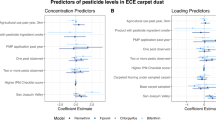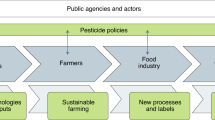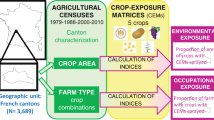Abstract
It is likely that household extermination is a major source of pesticide exposure for urban residents. Little is known about the predictors of residential pest control strategies in urban areas, and greater knowledge of these may help identify who is at risk for higher pesticide exposure. Study data is from the 2004 NYC Health and Nutrition Examination Surveys, a cross-sectional, population-based study using a three-stage sampling scheme. Logistic regression was used to identify predictors of pesticide use overall, and of application strategy: (1) consumer-applied pesticides only, (2) use of a professional exterminator only, or (3) use of both. Consumer-applied extermination was more prevalent than professional or both professional and consumer (39.9% versus 27.8% and 15.9%, respectively, and non-exclusively). In multivariate models among those who used any extermination, consumer application was associated with age 60 years+, being black or Asian, and being widowed, divorced, or single. Lower income households were more likely to use both strategies, and less likely to use professional extermination only. Urban residents may benefit from targeted education on how and when to self-apply pesticides, and on best-practice pest control to avoid unnecessary pesticide exposure. Higher prevalence of consumer-applied and conjoint consumer and professionally applied extermination in low-income households may reflect both economic determinants of first recourse and higher neighborhood infestation levels.
This is a preview of subscription content, access via your institution
Access options
Subscribe to this journal
Receive 6 print issues and online access
$259.00 per year
only $43.17 per issue
Buy this article
- Purchase on Springer Link
- Instant access to full article PDF
Prices may be subject to local taxes which are calculated during checkout
Similar content being viewed by others
Abbreviations
- DOHMH:
-
Department of Health and Mental Hygiene
- HANES:
-
Health and Nutrition Examination Surveys.
- NYC:
-
New York City
References
Arruda LK, Vailes LD, Ferriani VP, Santos AB, Pomes A, Chapman MD . Cockroach allergens and asthma. J Allergy Clin Immunol 2001; 107 (3): 419–428.
Perera FP, Illman SM, Kinney PL, Whyatt RM, Kelvin EA, Shepard P et al The challenge of preventing environmentally related disease in young children: community-based research in New York City. Environ Health Perspect 2002; 110 (2): 197–204.
Landrigan PJ, Claudio L, Markowitz SB, Berkowitz GS, Brenner BL, Romero H et al Pesticides and inner-city children: exposures, risks, and prevention. Environ Health Perspect 1999; 107 (Suppl 3): 431–437.
Quackenboss JJ, Pellizzari ED, Shubat P, Whitmore RW, Adgate JL, Thomas KW et al Design strategy for assessing multi-pathway exposure for children: the Minnesota Children's Pesticide Exposure Study (MNCPES). J Expo Anal Environ Epidemiol 2000; 10 (2): 145–158.
Stout DM, Bradham KD, Egeghy PP, Jones PA, Croghan CW, Ashley PA et al American Healthy Homes Survey: a national study of residential pesticides measured from floor wipes. Environ Sci Technol 2009; 43 (12): 4294–4300.
Lu C, Barr DB, Pearson M, Bartell S, Bravo R . A longitudinal approach to assessing urban and suburban children's exposure to pyrethroid pesticides. Environ Health Perspect 2006; 114 (9): 1419–1423.
Kass D . Biomonitoring as a policy lever: a case study of mercury and pesticide surveillance in New York City. Bulletin epidemiologique hebdomadaire 2009 (Special Edition) June 16, p. 14–17.
Horton MK, Rundle A, Camann DE, Barr DB, Rauh VA, Whyatt RM . Impact of prenatal exposure to piperonyl butoxide and permethrin on 36-month neurodevelopment. Pediatrics 2011; 127 (3): e699–e706.
Jurewicz J, Hanke W . Exposure to pesticides and childhood cancer risk: has there been any progress in epidemiological studies? Int J Occup Med Environ Health 2006; 19 (3): 152–169.
Lee DH, Steffes MW, Sjodin A, Jones RS, Needham LL, Jacobs DR . Low dose organochlorine pesticides and polychlorinated biphenyls predict obesity, dyslipidemia, and insulin resistance among people free of diabetes. PLoS One 2011; 6 (1): e15977.
Van Maele-Fabry G, Lantin AC, Hoet P, Lison D . Residential exposure to pesticides and childhood leukaemia: a systematic review and meta-analysis. Environ Int 2011; 37 (1): 280–291.
Wang J, Zhu Y, Cai X, Yu J, Yang X, Cheng J . Abnormal glucose regulation in pyrethroid pesticide factory workers. Chemosphere 2011; 82 (7): 1080–1082.
Grey CN, Nieuwenhuijsen MJ, Golding J . The use and disposal of household pesticides. Environ Res 2005; 97 (1): 109–115.
Williams MK, Rundle A, Holmes D, Reyes M, Hoepner LA, Barr DB et al Changes in pest infestation levels, self-reported pesticide use, and permethrin exposure during pregnancy after the 2000-2001 U.S. Environmental Protection Agency restriction of organophosphates. Environ Health Perspect 2008; 116 (12): 1681–1688.
Whyatt RM, Garfinkel R, Hoepner LA, Holmes D, Borjas M, Williams MK et al Within- and between-home variability in indoor-air insecticide levels during pregnancy among an inner-city cohort from New York City. Environ Health Perspect 2007; 115 (3): 383–389.
Gwynn RC, Mendel-Ricci J, Kass J, Goldfarb D, Thorpe T . Designing and Implementing a Community Health and Nutrition Examination Survey: The New York City Experience. Department of Health and Mental Hygiene: New York, NY: NYC. 2005 updated December 2005; cited 13 March 2011; Available from: http://www.nyc.gov/html/doh/html/hanes/howto.shtml.
Thorpe LE, Gwynn RC, Mandel-Ricci J, Roberts S, Tsoi B, Berman L et al Study Design and Participation Rates of the New York City Health and Nutrition Examination Survey, 2004. Altanta, Georgia. 2006. Cited 13 March 2011; Available from: http://www.cdc.gov/pcd/issues/2006/jul/05_0177.htm.
Thier AE, Klossner C . Plagued by pesticides: an analysis of New York State's 1997 pesticide use and sales data, 1998. Date last accessed August 2012.
Litt JS, Goss C, Diao L, Allshouse A, Diaz-Castillo S, Bardwell RA et al Housing environments and child health conditions among recent Mexican immigrant families: a population-based study. J Immigr Minor Health 2010; 12 (5): 617–625.
Rosenfeld L, Rudd R, Chew GL, Emmons K, Acevedo-Garcia D . Are neighborhood-level characteristics associated with indoor allergens in the household? J Asthma 2010; 47 (1): 66–75.
Wang C, Abou El-Nour MM, Bennett GW . Survey of pest infestation, asthma, and allergy in low-income housing. J Commun Health 2008; 33 (1): 31–39.
Tulve NS, Jones PA, Nishioka MG, Fortmann RC, Croghan CW, Zhou JY et al Pesticide measurements from the first national environmental health survey of child care centers using a multi-residue GC/MS analysis method. Environ Sci Technol 2006; 40 (20): 6269–6274.
Perera FP, Rauh V, Whyatt RM, Tang D, Tsai WY, Bernert JT et al A summary of recent findings on birth outcomes and developmental effects of prenatal ETS, PAH, and pesticide exposures. Neurotoxicology 2005; 26 (4): 573–587.
Butte W, Heinzow B . Pollutants in house dust as indicators of indoor contamination. Rev Environ Contam Toxicol 2002; 175: 1–46.
General Principles For Performing Aggregate Exposure And Risk Assessments. 2001 ed: Environmental Protection Agency Office of Pesticide Programs; 2012.
Kass D, McKelvey W, Carlton E, Hernandez M, Chew G, Nagle S et al Effectiveness of an integrated pest management intervention in controlling cockroaches, mice, and allergens in New York City public housing. Environ Health Perspect 2009; 117 (8): 1219–1225.
New Jersey Department of Health and Senior Services Consumer and Environmental Health Services Public Health SaSP. Bed Bug Fact Sheet. Trenton, NJ, Undated (cited 21 February 2011).
Joint Statement on Bed Bug Control in the United States from the U.S. Centers for Disease Control and Prevention (CDC) and the U.S. Environmental Protection Agency. Centers for Disease Control and Prevention: Atlanta; (cited 21 February 2011).
Bed Bug Information. U.S. Environmental Protection Agency: Washington, DC. 2011 (updated 16 February 2011; cited 21 February 2011); Available from: http://www.epa.gov/pesticides/bedbugs/.
Pesticide Applicator/Technician Information. NYS Department of Environmental Conservation: Albany, NY; 2011 (updated 2011; cited 5 May 2011); Description of pest control licensing requirements. Available from: http://www.dec.ny.gov/permits/45618.html.
Anderson AL, Leffler K . Bedbug infestations in the news: a picture of an emerging public health problem in the United States. J Environ Health 2008; 70 (9): 24–27, 52–53.
Goddard J, deShazo R . Bed bugs (Cimex lectularius) and clinical consequences of their bites. JAMA 2009; 301 (13): 1358–1366.
Pest Control in Public Housing, Schools and Parks: Urban Children at Risk, Law 180-4 PESP 202-7643. (2002).
Acknowledgements
Lorna Thorpe, PhD, Director of Epidemiology and Biostatistics, CUNY Hunter College, provided initial review.
Author information
Authors and Affiliations
Corresponding author
Ethics declarations
Competing interests
The authors declare no conflict of interest.
Rights and permissions
About this article
Cite this article
Ralph, N., Kelvin, E. Extermination strategies reported in the NYC Health and Nutrition Examination Survey, 2004: Prevalence and predictors. J Expo Sci Environ Epidemiol 23, 392–398 (2013). https://doi.org/10.1038/jes.2012.98
Received:
Revised:
Accepted:
Published:
Issue Date:
DOI: https://doi.org/10.1038/jes.2012.98



